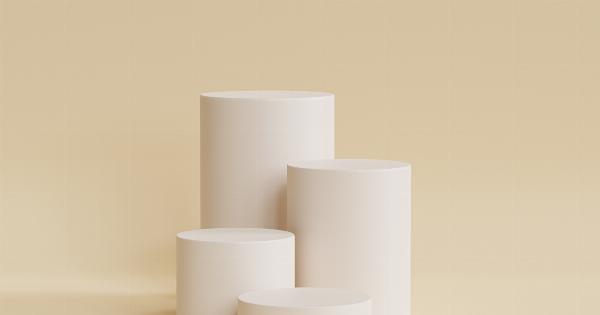Osteoporosis is a condition characterized by weakened and brittle bones, leading to an increased risk of fractures. It affects millions of people worldwide, especially older individuals, and has become a major public health concern.
While there are several well-known risk factors for osteoporosis, such as age, gender, and genetics, recent studies have raised concerns about the potential role of cleaning products in increasing the risk of this condition. In this article, we will explore the possible connection between cleaning products and osteoporosis and provide recommendations on how to minimize the risk.
Understanding Osteoporosis
Osteoporosis is a progressive condition that occurs when bone density decreases, making the bones weaker and more prone to fractures. It primarily affects postmenopausal women, but men can also develop osteoporosis.
The most common sites of fractures in individuals with osteoporosis are the hip, spine, and wrist.
Known Risk Factors for Osteoporosis
Before delving into the potential link between cleaning products and osteoporosis, it is essential to understand the established risk factors for this condition.
The following are some of the well-known factors that contribute to the development of osteoporosis:.
Age and Gender
As individuals age, their bone density naturally decreases, making them more susceptible to osteoporosis. Women, in particular, experience a significant decrease in bone density after menopause due to hormonal changes.
However, men can also develop osteoporosis, albeit typically at an older age than women.
Genetics
Family history plays a role in determining an individual’s risk of developing osteoporosis. If a parent or sibling has suffered from osteoporosis or fractures, it increases the likelihood of developing the condition.
Lifestyle Factors
Several lifestyle factors can increase the risk of osteoporosis, including smoking, excessive alcohol consumption, and a sedentary lifestyle.
Lack of physical activity and poor nutrition can contribute to decreased bone mass, further increasing the risk of osteoporosis.
The Potential Connection Between Cleaning Products and Osteoporosis
While many risk factors for osteoporosis are well-established, recent research has indicated a potential link between exposure to certain cleaning products and an increased risk of developing the condition.
Cleaning products often contain chemicals that may negatively impact bone health.
Chemicals of Concern
Some chemicals commonly found in cleaning products have been associated with bone loss and an increased risk of fractures. One such chemical is triclosan, which is often used in antimicrobial soaps and cleaning agents.
Studies have suggested that triclosan can disrupt normal bone cell metabolism, leading to weakened bones and an increased risk of osteoporosis.
Phosphates in Cleaning Products
Phosphates are commonly used in household cleaning products, particularly dishwasher detergents. While phosphates are effective in removing stains, they can have detrimental effects on bone health.
Regular exposure to phosphates has been linked to an increased risk of osteoporosis due to their ability to interfere with calcium absorption and promote bone loss.
Fragrances and VOCs
Many cleaning products contain fragrances, which can release volatile organic compounds (VOCs) into the air. These VOCs have been associated with a variety of health concerns, including respiratory issues and hormonal imbalances.
Some studies have suggested a potential link between exposure to VOCs and weakened bone density.
Preventing Osteoporosis While Using Cleaning Products
While the potential connection between cleaning products and osteoporosis is concerning, there are steps you can take to minimize your risk. Here are some recommendations:.
Choose Safer Cleaning Products
Opt for cleaning products that are free from chemicals of concern, such as triclosan and phosphates. Look for labels indicating “phosphate-free” and “triclosan-free” to ensure you are selecting safer alternatives.
There are now many eco-friendly and non-toxic cleaning products available in the market.
Read Product Labels
Take the time to read the labels of cleaning products before purchasing them. Look for any warning labels or indications of harmful chemicals. Avoid products with strong fragrances, as they may contain VOCs that can affect your health.
Protective Measures
When using cleaning products, take protective measures to minimize exposure. Wear gloves, use cleaning agents in well-ventilated areas, and ensure that the area is adequately ventilated during and after cleaning.
This can help reduce inhalation and skin contact with potentially harmful chemicals.
Natural Cleaning Alternatives
Consider using natural cleaning alternatives, such as vinegar, baking soda, and lemon juice. These ingredients are effective in cleaning various surfaces and are generally safer for both your health and the environment.
There are many online resources and books available with recipes for making natural cleaning products.
Diet and Exercise
In addition to minimizing exposure to harmful chemicals, maintaining a healthy lifestyle is crucial for supporting bone health. Consume a balanced diet rich in calcium, vitamin D, and other essential nutrients for bone strength.
Engage in weight-bearing exercises, such as walking, jogging, or resistance training, to help improve and maintain bone density.
Conclusion
While further research is needed to establish a definitive link between cleaning products and osteoporosis, taking precautions to minimize exposure to potentially harmful chemicals is a prudent approach.
By choosing safer cleaning products, reading labels, and adopting natural cleaning alternatives, you can reduce your risk while keeping your home clean and tidy.






























